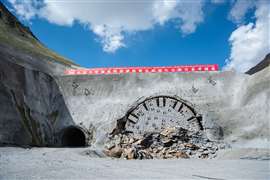Cutting-edge demolition and recycling techniques
13 May 2014

As with other parts of the construction equipment world, the latest engine regulations are driving the development of new machines in Europe and North America. The industry is currently moving from the Stage IIIB/Tier 4 Interim laws to Stage IV/ Tier 4 Final, and it looks like many manufacturers are waiting for this latter stage to come fully into force before updating their ranges of high-reach demolition excavators – a low volume, niche product.
As always, there are exceptions to the rule and in this case they come from Volvo and Hitachi. Volvo launched Stage IIIB versions of its 27.4 m reach EC480DHR and the 21 m EC380DHR at last April’s Bauma exhibition.
Hitachi meanwhile developed a Stage IIIB high-reach version of its 45 tonne class ZX470-5LCH excavator for German contractor B Trinkl, which required the lowest emission machine available on the market to be allowed to work on a residential redevelopment in Munich, Germany. The ZX470 high reach has a pin height of 25 m with a maximum tool weight of 2.5 tonnes.
It is reasonable to suppose that when the next engine evolution is achieved and manufacturers have carriers available with Stage IV/Tier 4 Final compliance, development work will start on the next generation of demolition specification standard machines and their high reach variants.
Specialist suppliers
But when it comes to high-reach machines, the household names in the construction equipment industry are only part of the story. There are several specialist engineering companies that modify standard excavators into high-reach machines, and many add innovative features when they carry out this work.
When high reach excavators first emerged, they were dedicated machines that could only be used in that role. Over time, coupling systems were developed to allow them to be used in both high reach and standard boom configurations, with change-over times coming down over the years to, in some cases, less than half an hour on today’s modern machines.
The last two years have seen this need for flexibility addressed even further by the development of new concepts. This has reached the point where a single carrier can be supplied with a range of front ends allowing it to be used across different applications in addition to demolition and standard dig work.
One company at the forefront of this is Kocurek Excavators, based in Ipswich, UK. In 2013, working together with UK demolition contractor Armac, which was the driver behind the project, it developed what is now known as the ABC concept. This consists of a single carrier than can be equipped with three different front ends that provide variable working heights and tool sizes in addition to a standard dig boom. This allows the machine to be tailored to the application, but more importantly, only the single carrier is required for four potential applications if all boom configurations are available.
And the flexibility concept is being taken a massive step further by Kocurek working in partnership with German Hitachi dealer Kiesel. The result is a single carrier, in the first instance a Hitachi ZX470LC, which is able to carry an even wider range of booms for a variety of different applications for German customer AWR.
It is the first in what will be known as the KMC470-BTV range. KMC is the acronym for Kiesel Multi Carrier, with the B standing for the OilQuick boom connect system, T for the Tritech three cylinder quattro valve lift system and V for variable undercarriage. The idea is that every 470 produced will have the same stub boom with the OilQuick and three lift cylinders. The three cylinders provide the necessary power when in demolition mode with the valve providing more normal flows for when the machine is in a standard excavation configuration.
Range of booms
Kiesel and Kocurek are developing a range of booms for the carrier, offering vertical reaches from 18 m to 34 m for demolition work, as well as materials handling equipment and the standard excavator boom.
The concept is also being applied to Hitachi’s ZX350 machine to turn it into the KMC350-BTV. The various boom options will allow this to work as a standard excavator, materials handler or demolition excavator with a range of reaches up to 24 m.
The fact that companies like Kiesel and Kocurek are at the cutting edge of high-reach demolition excavator design underlines the fact that this is an area where European companies tend to lead the way. However, that is not to say that high reach machines are only used in Europe. Far from it.
Visitors to this year’s ConExpo-Con/Agg exhibition in Las Vegas, US can’t have failed to notice the high-reach machine on Kobelco’s stand.The 112 tonne SK1000 DLC offers a maximum reach of 38 m.
The Japanese manufacturer said that it would be bringing 19 variants of its demolition machines into the US, along with 12 scrap handlers, over the next few months. Interestingly, Kobelco said at the time there were no plans to bring these machines to Europe, although it added that it is continuously evaluating its options.
Explosive demolition
As popular as mechanical demolition, using machines like high-reach excavators, has become, there is still a place for techniques using explosives. Contrary to the images the phase ‘explosive demolition’ may conjure up in the minds of those outside the industry, projects like these are precisely engineered exercises.
Fabio Bruno’s triple blow down in Niterói, Brazil is a good example of how modern explosive demolition is carried out. It took place on 2 November, 2012, and the success of the contract saw the project go on to win the 2013 World Demolition award for explosive demolition.
The job involved the implosion of three reinforced concrete buildings with seven, six and five storeys respectively in the city of Niterói. The buildings belonged to the former Santa Monica Hospital that had been out of use for over 10 years and the close proximity of other buildings, electrical cables and structures on all sides raised concern prior to the implosion.
Work began on October 1 2012 to ‘soft strip’ the buildings of any timber and other non-structural materials which could be re-used. It was also easier to remove material at this stage, rather than after the implosion for ease of sorting and recycling. Following the soft strip, screens were positioned around the outside of every floor that would have charges placed in them to guard against flying debris.
The implosion sequence of the supporting columns was designed based on a simulation by Applied Science International (ASI). The concept was to keep the implosion in the centre of the buildings, rather than towards the edges, to cause them to fall inwards and away from surrounding obstructions.
Other measures were taken, such as the use of steel cables in the second building to ensure that the structure’s water tank did not fall towards an adjacent flower shop.
When it came to the implosion, delays of 300 milliseconds were set up between the blasts on each set of columns, starting at the centre of the building, with the perimeter columns the last to go. In fact, some of the perimeter columns were not blasted to help ensure all the debris remained on the existing buildings’ footprint.
The charge ratio of the implosion was 0.300 kg per m3 of column volume. This ratio prevented any fragments from penetrating the screens and hitting other buildings in the vicinity. A total of
130 kg of explosives was used, spread over 1,200 manually drilled holes.
The implosion was carried out at 8:00 am on November 2, 2012. No power cables were damaged during the event, and in addition no cracks in any of the adjacent buildings were observed, while all the debris from the implosion was contained inside the building footprint, as predicted by the engineers behind the project. The peak particle velocity recorded by seismographs was below 3 mm/s, which was safely below the maximum limit of 15 mm/s allowed under Brazilian standards.
This all illustrates how sophisticated the demolition industry is, be it through scientifically engineered explosive demolition, or the latest in flexible demolition machines.






